LG Ultragear 48GQ900-B review: A huge 4K OLED monitor from the king of TVs
Expert’s Rating
Pros
- Excellent HDR image quality
- Great motion clarity with G-Sync, FreeSync support
- Attractive contrast, wide color gamut
- Works well when connected to a PC
Cons
- Color performance has issues at default settings
- Sharpness could be improved
- Stand offers no adjustment, no VESA mount
Our Verdict
The LG Ultragear 48GQ900-B doesn’t easily fit into a specific genre of computer monitors. Mainly, it’s just really big and has excellent image quality. With that said, while the HDR and motion clarity are top of the line, the unusually low brightness and steep price tag hold it back from greatness. If you’re looking for a huge 4K screen for your PC then this display is perfect, otherwise you may find something more suitable to your needs for less.
Price When Reviewed
1,499.99
Best Prices Today: LG Ultragear 48GQ900-B

$1,166.99
PC gamers have flocked to LG’s 4K OLED televisions since their introduction, and for good reason. These large, attractive, high-contrast displays offer a much better contrast ratio and superior HDR when compared to most desktop monitors. The LG Ultragear 48GQ900-B specifically targets this audience with features specific to the PC, like DisplayPort input and a high refresh rate. It mostly hits the mark.
Note: This review is part of our ongoing roundup of the best 4K monitors. Go there to learn about competing products, what to look for in a 4K monitor, and buying recommendations.
LG Ultragear 48GQ900-B: The specs
The LG Ultragear 48GQ900-B is a 4K, 48-inch widescreen display. Its specifications are typical of any premium 4K monitor, but that’s kind of the point. It includes DisplayPort, which is not found on most televisions, and has a maximum refresh rate of 138Hz.
- Display size: 48-inch widescreen
- Native resolution: 3840×2160
- Panel type: OLED
- Refresh rate: 138Hz
- HDR: Yes, HDR10
- Ports: 3x HDMI 2.1, 1x DisplayPort, 1x USB-B upstream, 2x USB-A, 1x 3.5mm audio out, 1x optical audio out
- Stand adjustment: None
- VESA mount: No
- Speakers: Yes
- Price: $1,499.99 MSRP ($1,199.99 typical).
But the real star is, of course, the OLED panel, which hits an alluring MSRP of $1,499.99 (and it’s often hundreds less when on sale). That’s expensive, but it feels like a steal when compared to the $1,299.99 Alienware AW3423DW or the $3,499 Asus ProArt PG32DC.
LG Ultragear 48GQ900-B: Design
Are you a gamer? Then you must like gamer things, right? That’s clearly the thought behind the LG Ultragear 48GQ900-B. The monitor has an aggressive look with faux vents, a hexagonal pattern, and built-in LED lighting.
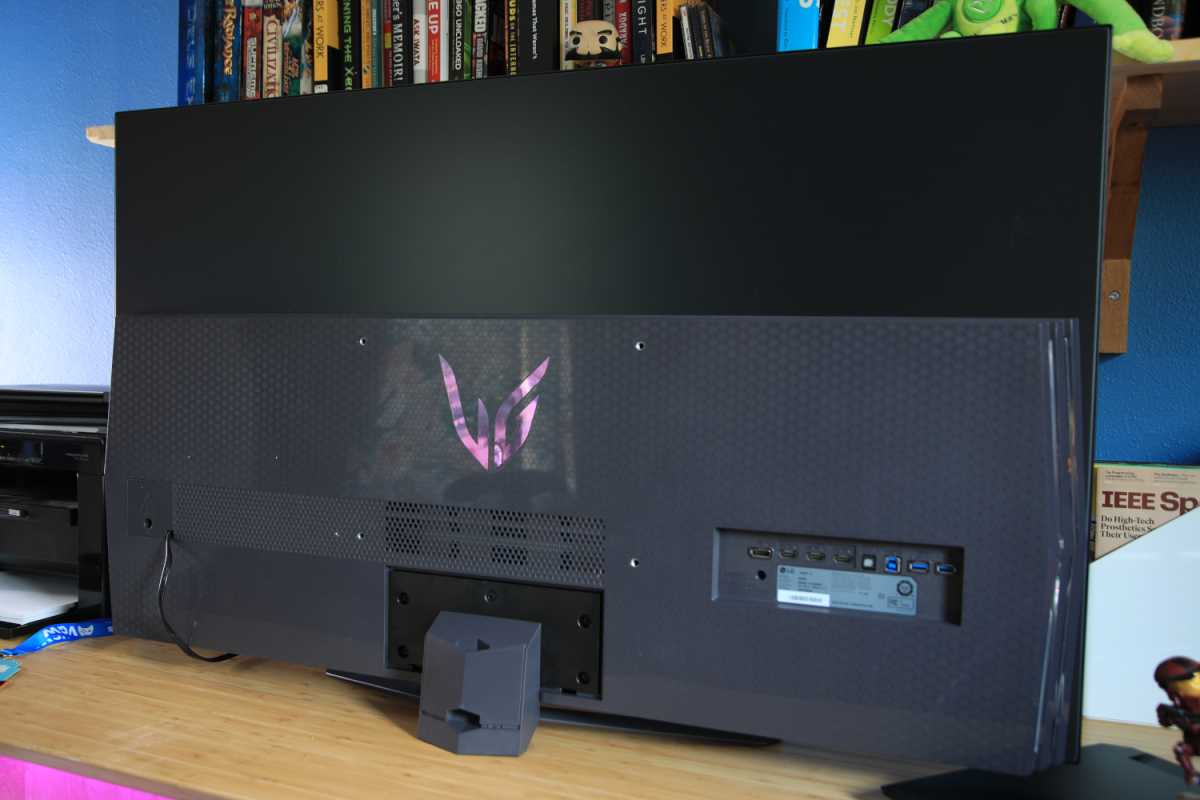
An aggressive design makes the LG Ultragear 48GQ900-B visually appealing to gamers.
Matt Smith
It’s all a bit edgy for my tastes, yet I’ll admit the built-in LED lighting can be useful. It’s bright enough to provide luminance on a desk and can be used to replace an LED light strip behind or under your desktop.
LEDs aside, the monitor’s looks are a moot point once it’s set up. The display measures less than two inches thick at its thickest point and, because of its size, will usually be placed against a wall. Most people will never see the rear of the monitor except when connecting or disconnecting devices.
A wide silver stand holds the monitor aloft. Although large, it’s not oversized relative to the display, which minimizes the monitor’s footprint (the LG C2 OLED television, by comparison, has a much wider stand). The stand doesn’t adjust, not even for tilt, which is normal for monitors of this size. A standard VESA monitor mount isn’t included but TV wall mounts are supported.
LG Ultragear 48GQ900-B: Features and menu
LG packs a ton of connectivity in the Ultragear 48GQ900-B. Video input includes three HDMI 2.1 ports alongside one DisplayPort 1.4. This covers any scenario I can imagine. It’s possible to connect a PC (through DisplayPort), PlayStation 5, Xbox Series X at once—and still have room for a 4K streaming stick or box.
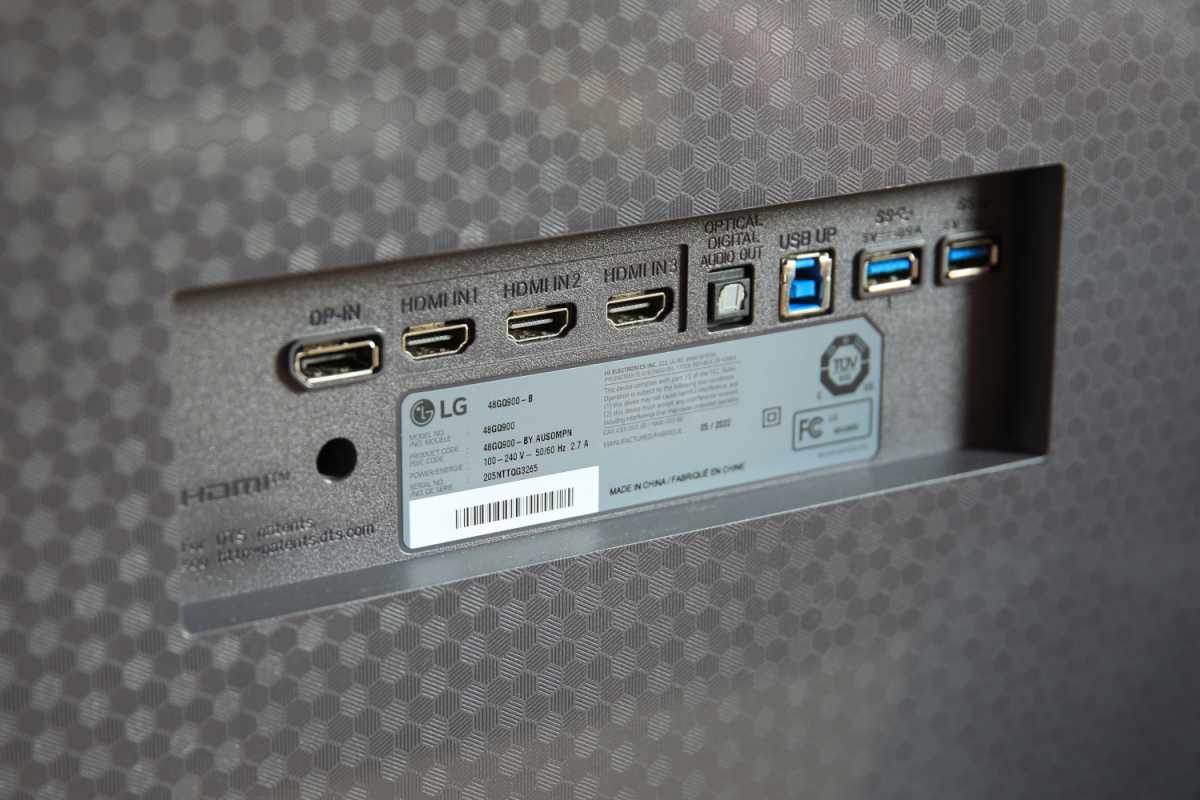
The LG Ultragear 48GQ900-B comes with a ton of connectivity options.
Matt Smith
It also includes 3.5mm audio and optical audio out, providing two options for passing through audio to a soundbar or speaker system. This is a feature not all monitors of this type provide, and it’s an ideal arrangement if you want to use it in a PC-centric home theater. I used the optical output with my soundbar and had zero issues.
There’s also a USB-B upstream port that connects to two USB-A ports. This makes the monitor a basic USB hub, which is useful if you use wired peripherals. The monitor lacks USB-C and doesn’t offer the expansive connectivity of a productivity-focused monitor like the Dell Ultrasharp U3223QE.
A bundled remote control is available for accessing the menu. It has a big, fat dial and just six buttons. It felt confusing to use at first but eventually won me over. This is a monitor, not a television, so a simplified layout makes sense.
The menus are well labeled and offer the usual range of adjustment. This includes four gamma plus and seven color temperature modes, though none promise to target a particular gamma curve or color temperature. It has six-aix color adjustment for saturation and hue. There’s gaming options, too, such as a black stabilizer, built-in crosshair, and FPS counter.
LG includes an sRGB mode that can be used to reel in the wide color gamut, if needed. However, DCI-P3 and Rec.709 modes are not available.
The LG Ultragear 48GQ900-B has built-in speakers. They’re much better than what is typical of a monitor and sound good in general use at middling volume, but audio quality takes a dive as volume increases. The mid-range becomes muddy and harsh. Explosions in an action movie, for instance, sound more akin to static. It’s fine on a desktop, where it’s more likely to be used at low volume, but not suited for home theater.
Finally, it’s worth mentioning the LG Ultragear 48GQ900-B is a monitor, not a television, which means it doesn’t have a TV tuner. It doesn’t have a coaxial input and won’t accept a traditional antenna or cable signal (without passing it through another device, at least).
LG Ultragear 48GQ900-B: SDR image quality
I’ll start with a statement: Monitors are not televisions, televisions are not monitors, and the traits that make a display excel in one category may not make it better for the other. With that said, let’s dig in, because there’s a lot to talk about.
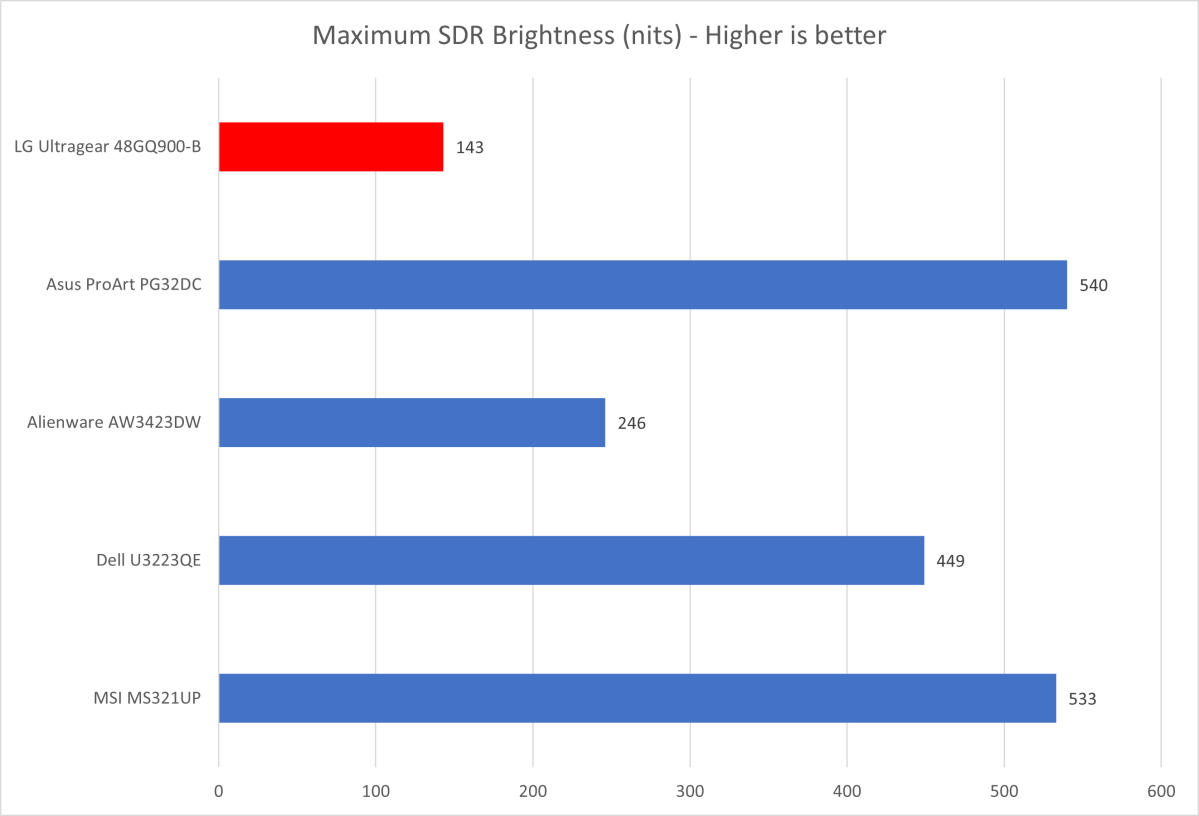
Matt Smith
SDR brightness is very low at a maximum of 143 nits. That, as is obvious from the graph, lands way behind any other monitor that I’ve recently tested. It’s also quite far behind the Alienware AW3423DW, which like the Ultragear has an OLED panel (albeit a much different implementation). The Ultragear 48GQ900-B’s performance is not unusual. Most OLED televisions will perform similarly when asked to display a bright, white image across the entire display.
Is this a problem? It could be. Brightness felt high in my home theater, but merely adequate on my desk, even when set to maximum brightness. A matte display coat helps diffuse light, but glare was a minor issue on sunny days. The monitor is ultimately best in a room with windows that can at least partially block sunlight and no harsh overhead lights.
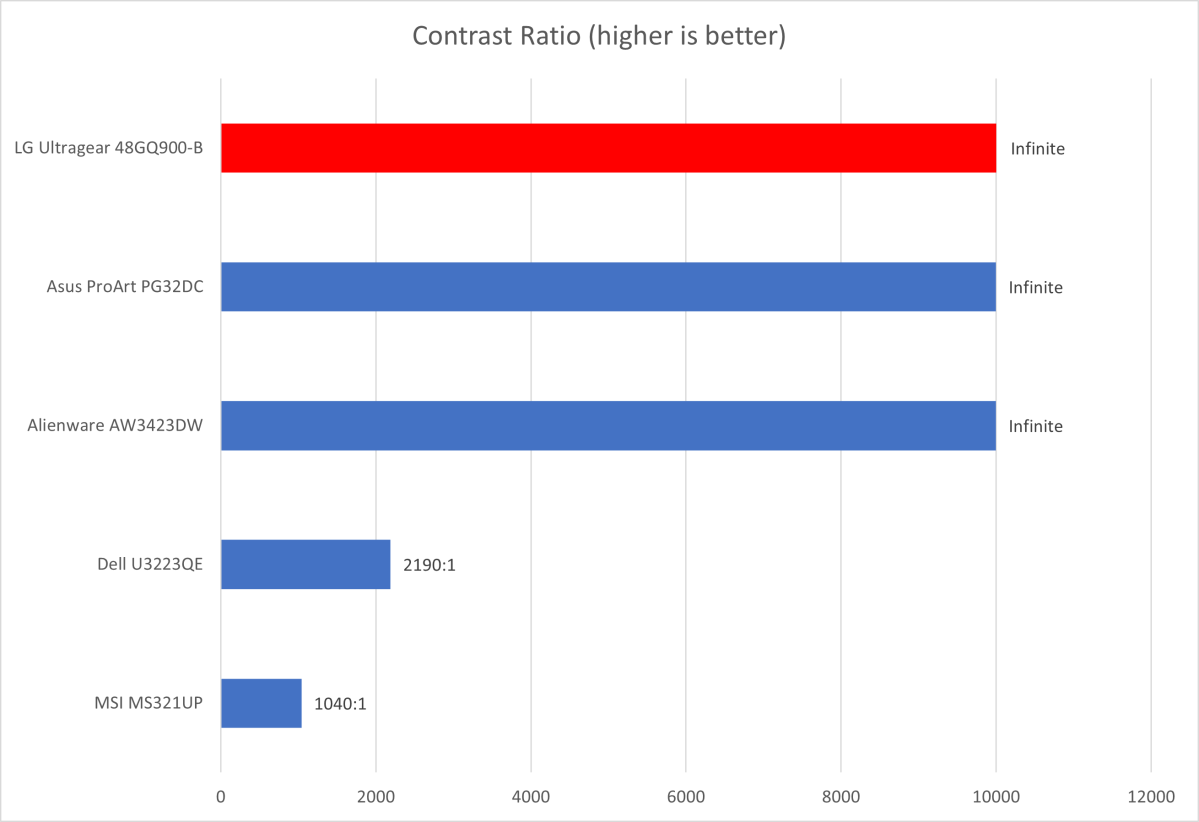
Matt Smith
Contrast, on the flip side, is much better than average, with an effectively infinite contrast ratio. This is thanks to the OLED panel’s ability to turn each pixel on or off individually. Pixels are almost perfectly black, appearing indistinct even in a pitch-black room. It’s a big upgrade from the hazy, gray-ish look most monitors provide in dark scenes.
The great contrast ratio provides an excellent sense of depth and dimensionality. At times, when fed high-quality 4K content, the Ultragear 48GQ900-B’s image begins to look 3D dimensional. It’s a dramatic effect that won’t be found on any LCD monitor lacking a Mini-LED backlight, and even those are not quite as effective.
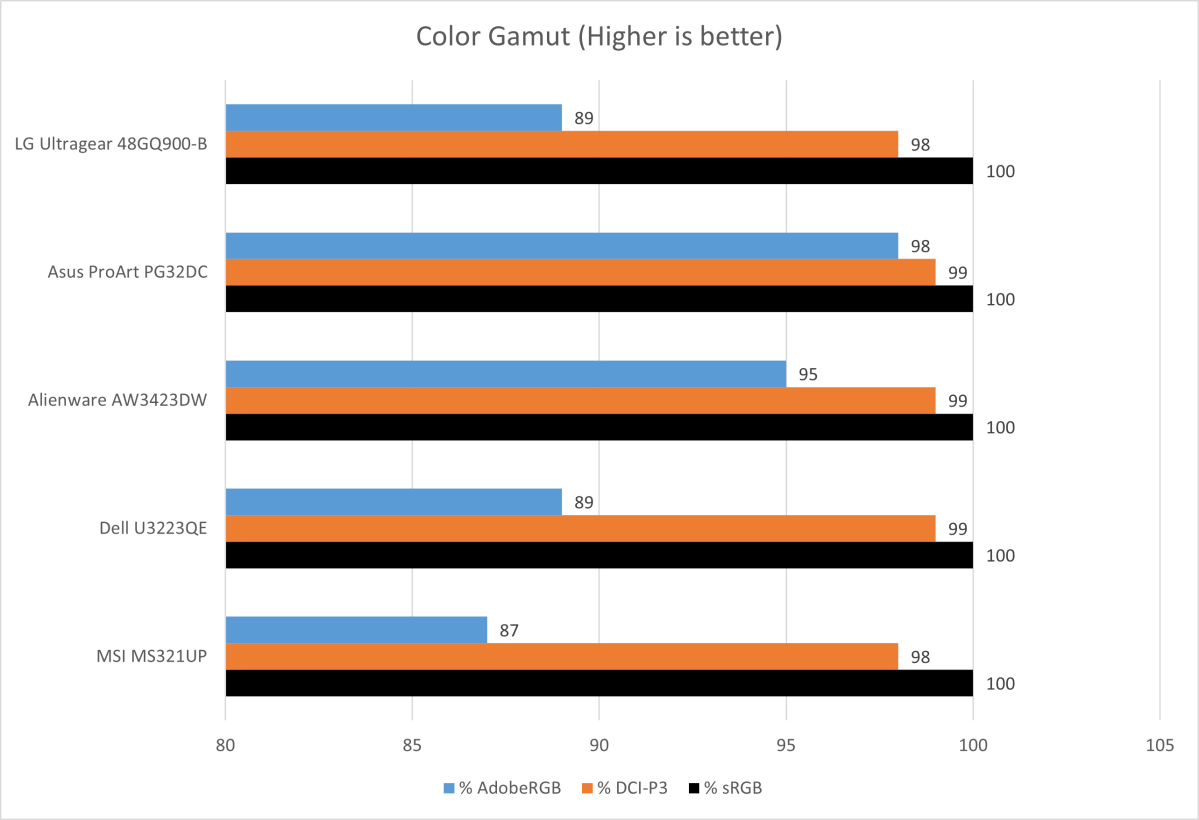
Matt Smith
Color gamut came in strong, reaching across all of sRGB and 98 percent of DCI-P3. There are a few monitors that can beat the LG Ultragear 48GQ900-B: the Asus ProArt PG32DC, a high-end professional OLED monitor, is one example. Still, a color gamut this wide is excellent for general use and provides a vivid, alluring look.
The monitor also supports 10-bit color, which helps cut down on the color banding that may appear in color gradients, such as the subtle hues of blue found in a skybox, or the mellow oranges and purples that surround a setting sun. Banding, when it is visible, pops up most often in grayscale—but it’s still rather subtle. I doubt most viewers would ever notice.

Matt Smith
Color accuracy, on the other hand…well, this is where things get complicated.
I’ve listed color accuracy for default, sRGB, and software calibrated settings. I don’t normally do this, because I judge a monitor’s out-of-the-box experience to be its most important trait, and the default by which most people will judge it. In this case, however, default color accuracy was way off. Color accuracy was much better with some effort to bring it in line, though still not great.
A few problems contribute to the Ultragear 48GQ900-B’s out-of-box woes.
First, the default color temperature came in way too high at 10200K, off a target of 6500K. Second, gamma was off target with a gamma curve of 2.4. This means the image appears much cooler, more blue, and darker than it should.
It’s a usable image, but the color issues are apparent and left me unhappy. It was bad enough that I tested the display with a second computer, which I don’t normally do. The results persisted.
A calibration mostly resolves the problem. The Ultragear 48GQ900-B remained relatively inaccurate, but close enough for general use. Given its other strengths, I would accept this level of error in exchange for the monitor’s contrast ratio, HDR performance, and color accuracy, which I’ll talk more about shortly.
Sharpness can also be an issue, depending on how the monitor is used. This may seem surprising for a 4K monitor, but the 4K 48-inch panel works out to only 91 pixels per inch. Pixel density is almost identical to a 24-inch 1080p monitor.
Finally, the Ultragear 48GQ900-B has a RWBG pixel layout rather than the RGB layout common to most monitors. This is a problem because Windows is optimized for RGB. The monitor shows noticeable fringing around text which can cause it to appear blocky or pixelated when it should appear smooth. It’s an issue the monitor shares with the Alienware AW3423DW. Asus’ ProArt PA32DC, which is more expensive, doesn’t have this issue.
SDR performance is a mix, then. The contrast ratio is excellent, and the color gamut is wide, but brightness and color accuracy are notable issues. The Ultragear 48GQ900-B’s problems can make it inconvenient to use and prevent it from working well in professional workflows. It’s a much better monitor for entertainment than productivity.
LG Ultragear 48GQ900-B: HDR image quality
The LG Ultragear 48GQ900-B’s HDR performance is important given its intended use. Though it might be used on a desk, it can also be used in a home theater, in which case it’ll spend more time in HDR mode than in SDR.
I measured a maximum full-screen HDR brightness of 221 nits. That’s low, falling well behind a typical IPS edge-lit monitor and way, way behind Mini-LED displays. It’s also behind the Alienware AW3423DW, which hit 325 nits, and the Asus ProArt PA32DC, which reached 540 nits.
Brightness can ramp up to more than 400 nits in a 10 percent window (in other words, when only 10 percent of the display panel is lit). Other reviewers, such as IGN, have noted up to 600 nits in a one-percent window, which is not a situation I’m set up to test.
Whether this level of brightness is good or bad has a lot to do with how, and where, you use the monitor. Brightness felt excellent when placed in my darkly lit home theater but remained less impressive in my office.
But let’s be real: Whatever the brightness, the Ultragear 48GQ900-B demolishes the performance of any monitor lacking an OLED panel or Mini-LED backlight. Most monitors have no problem with brightness but are lacking in contrast, so they can’t handle the range of luminance HDR provides. This monitor’s excellent contrast helps to fix that issue, which results in a richer, deeper image.
It also benefits from a well-behaved brightness limiter. This is a downside of Alienware’s AW3423DW, which can suffer aggressive and obvious swings in brightness when transitioning between scenes of significantly different brightness, or when bright objects (like a Word document) are resized. This comes into play with the Ultragear 48GQ900-B, but transitions are more muted and less distracting.
On a final note, the Ultragear 48GQ900-B only supports HDR10 (which means it doesn’t support Dolby Vision). I don’t see this as a problem because Dolby Vision HDR isn’t frequently used on the PC. However, this might be a concern if you plan to use the monitor in a home theater. Overall, the LG Ultragear 48GQ900-B’s HDR performance is great. Personally, I prefer the brighter and more stable presentation of a Mini-LED display, like the Asus ROG Swift PG32UQX or Viewsonic XG321UG, but LG’s alternative is excellent. It’s a compelling HDR experience that will have you eager to use HDR whenever possible.
LG Ultragear 48GQ900-B: Motion clarity
Motion performance is key to the LG Ultragear 48GQ900-B’s appeal. It supports overclocking to a maximum refresh rate of 138Hz and is compatible with both Nvidia G-Sync and AMD FreeSync Premium.

Matt Smith
Motion clarity is superb at both 138Hz and 120Hz. Fine detail is preserved when panning a camera in a 3D game and small objects are easy to track when moving across the scene. Details like character models and health bars remain visible when moving the camera across the map in League of Legends. Text displaying character names is only sometimes legible, but that’s still a great result at these refresh rates. Such text usually isn’t legible on a monitor with a refresh rate below 240Hz.
Even 60Hz looks good which, given the Ultragear 48GQ900-B’s intended use, is a wonderful trait. PC users won’t have trouble making full use of high refresh rates, but console games often render at just 60fps (or lower). The monitor looks good in these situations, as it can preserve some fine to medium details when panning a camera or tracking a fast object.
I have just two nits to pick. First, the 138Hz overclock is more of a marketing ploy than a real, useful feature, as the difference between 138Hz and 120Hz isn’t noticeable. The monitor also lacks a backlight strobing feature to further improve motion clarity.
Even so, the Ultragear 48GQ900-B’s overall motion performance is remarkable. It ranks alongside the motion performance of Alienware’s AW3423DW and delivers a noticeable, improvement over IPS and VA-panel monitors with a 144Hz or 120Hz refresh rate.
LG Ultragear 48GQ900-B vs. LG C2 OLED
PC owners looking for a large OLED display might compare the LG Ultragear 48GQ900-B with the LG C2 OLED. They both carry a retail MSRP of $1,499.99, and both are currently on sale at multiple retailers for $1,199. They are similar in size and seem to promise similar performance. So, what’s the difference?
The LG Ultragear 48GQ900-B, as mentioned, is a monitor. It doesn’t have the TV tuner, smart TV apps, and AI image processor found in the LG C2 OLED. In exchange, the 48GQ900-B gains DisplayPort, a USB hub, and a higher maximum refresh rate of 138Hz. The lack of image processor is also arguably a perk because it reduces latency. LG’s C2 OLED offers a game mode which gets around this, but the Ultragear 48GQ900-B doesn’t need that. It’s always in game mode.
Because of these differences, the LG Ultragear 48GQ900-B is better for playing games or viewing content on a PC, while the LG C2 OLED is superior for streaming, 4K Blu-Ray movies, and over-the-air TV.
Both are great for console gaming, though I’d say the LG C2 OLED has an edge because of its support for Dolby Vision HDR, which is available on Xbox Series X and PlayStation 5.
Should you buy the LG Ultragear 48GQ900-B?
The LG Ultragear 48GQ900-B’s performance is hard to summarize. It’s a display that has incredible strengths, such as its HDR performance and motion clarity, and obvious weaknesses, like out-of-box color problems and low SDR brightness.
But I can say this: I like it. The monitor looks gorgeous when playing modern titles like Deathloop, of course, but it’s also amazing in older games. The Elder Scrolls V: Skyrim, played at 4K with high-resolution textures and Windows Auto HDR on, looks fantastic. It’s painful to go back to an IPS panel monitor after seeing this.
Pricing is the final, and important, factor. The Ultragear 48GQ900-B debuted at an MSRP of $1,499.99, but it’s now on sale at multiple retailers (and listed on LG’s website) at $1,199.99. That’s no bargain, but it’s less expensive than a number of smaller Mini-LED and OLED monitors. The Ultragear 48GQ900-B is a solid, though not flawless, choice if you want a huge screen for your PC.
For all the latest Technology News Click Here
For the latest news and updates, follow us on Google News.
